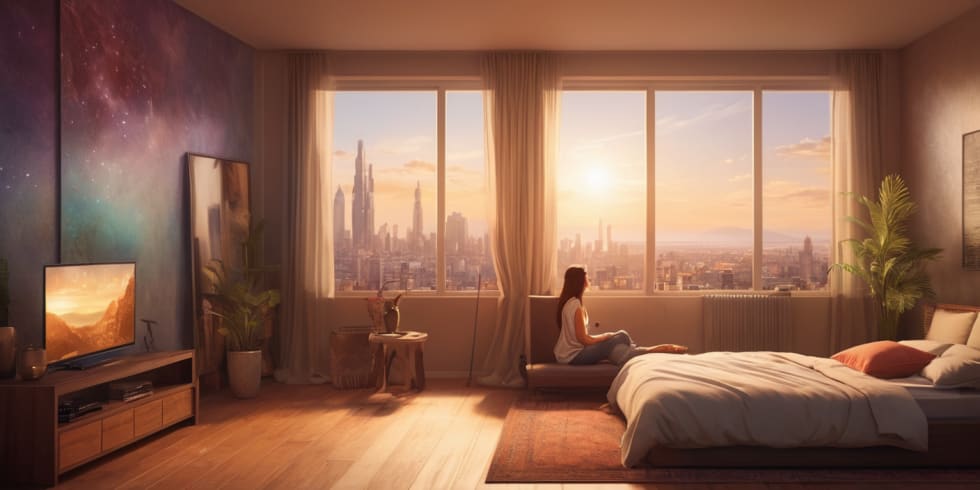Soundproof Your Sanctuary: Renter-Friendly Techniques for Peaceful Living
Introduction
Did you know that long-term exposure to noise pollution can significantly increase stress levels and negatively impact your health? For renters, especially those in densely populated areas, the challenge of noise is a constant battle. Whether it’s the hustle and bustle of city life, noisy neighbors, or even just the hum of daily living, unwanted sound can easily invade our living spaces, turning our homes from sanctaries into sources of stress.
Looking for ways to soundproof your apartment without losing your deposit? Fear not! The objective of this post is to arm you with renter-friendly, reversible soundproofing techniques. Our goal is to help you create a peaceful living environment, one where you can relax, work, and play without being constantly disturbed by outside noise. So, if you’re ready to turn down the volume on your living situation, keep reading for some sound advice on soundproofing your rental.

Identifying Your Noise Challenges
Before diving into the world of soundproofing, let’s pinpoint where that racket is coming from. Identifying the main culprits behind your noise woes is the first step toward reclaiming your peace and quiet. Here’s a rundown of common noise sources to watch out for:
- Doors: They’re not just for coming and going; unfortunately, they’re also a prime pathway for noise. Look out for gaps at the bottom or around the edges that might be letting sound sneak in.
- Windows: Ah, windows. They let in the sunlight, the breeze, and… the noise. Thin glass and cracks can turn your windows into unintentional speakers.
- Shared Walls: Living in close quarters with others means you might be getting an earful of their life soundtrack, thanks to those shared walls.
Quick Noise Assessment Checklist: To help you figure out where the noise is invading your space, I’ve put together a little checklist. Grab a notepad and assess your apartment at different times of the day to get a full picture of your noise challenges.
Morning Rush Noise Sources
Is the sound of traffic or neighbors’ morning routines filtering in? Note which areas of your apartment are most affected.
Afternoon Noise Check
Pay attention to any construction noise, kids playing outside, or other daytime disturbances. Are your windows or walls letting in too much sound?
Evening Noise Evaluation
As the day winds down, do you find yourself disturbed by neighbors’ TVs, conversations, or footsteps? This could indicate poorly insulated walls or floors.
Nighttime Quiet Assessment
Notice any sounds that disrupt your peace during the night, like late-night traffic or neighbors coming home. Doors and windows might be the main culprits here.
Understanding your apartment’s specific noise issues will not only help you target your soundproofing efforts more effectively but also ensure that you’re investing your time and resources into the right solutions. Plus, knowing exactly what you’re up against can make those conversations with neighbors or landlords a bit easier down the line.

DIY Soundproofing Basics
Transform your apartment into a tranquil retreat with these simple and cost-effective soundproofing strategies:
Seal Gaps Around Doors and Windows
A door sweep or weather stripping can significantly block noise from hallways or outside. These affordable and easy-to-install solutions can make a big difference in reducing the amount of noise that enters your space. By sealing the gaps around your doors and windows, you prevent the external sounds of the city or noisy neighbors from disrupting the peace of your home, creating a more serene and quiet environment.
Utilize Soft Furnishings to Absorb Internal Noise
Adding rugs, heavy curtains, plush sofas, and bookshelves filled with books can help absorb sound within your apartment. Not only do these items contribute to the overall aesthetic of your living space, making it more inviting and cozy, but they also play a crucial role in muffling sounds. This approach to soundproofing is both practical and decorative, offering a way to enhance the quietness of your apartment without sacrificing style.
By incorporating these soundproofing techniques, you can achieve a quieter and more peaceful living environment. These strategies are especially beneficial for renters looking for reversible and budget-friendly options to minimize noise in their apartments.

Advanced Soundproofing Techniques
Ready to level up your soundproofing game? Let’s dive into some advanced techniques that pack a punch in the quest for tranquility without causing a fuss with your landlord or breaking the bank.
High-Quality Soundproofing Curtains
First up, if you thought curtains were just for privacy or sprucing up your decor, think again. Soundproofing curtains are a heavyweight champion in the battle against noise. They’re designed to dampen external sound, turning down the volume on everything from busy street noise to the neighbor’s late-night TV marathons. The beauty of these curtains lies in their simplicity - they hang just like any other curtain but work overtime to keep your space quiet. For a top recommendation, check out these High-Quality Soundproofing Curtains that combine style and function, making them an excellent addition to any renter’s noise reduction toolkit.
White Noise Machine for a Serene Atmosphere
Sometimes the best way to block out noise is with more noise - but the right kind. Enter the white noise machine, your new best friend for creating a consistent, soothing backdrop that masks unwanted sounds. Perfect for sleep, meditation, or just a calmer work-from-home environment, a white noise machine can make all the difference. The Efficient White Noise Machine is a standout option, offering a variety of soundscapes to transport you away from the cacophony outside to a more serene setting.
Acoustic Panels
For those of you dealing with thinner walls or particularly loud areas, acoustic panels can be a game-changer. These panels absorb sound before it has a chance to bounce around your space, significantly reducing noise levels. The best part? Many modern options are designed with renters in mind, featuring easy installation and removal so you can take them with you when you move. They come in various sizes and styles, ensuring that you can find something that not only serves its purpose but also complements your interior.
Easy Installation and Removal
One of the biggest concerns for renters is avoiding damage to the apartment that could cost you your security deposit. Thankfully, the soundproofing solutions mentioned above are all about convenience and reversibility. Soundproofing curtains can be hung on existing curtain rods, white noise machines simply need an outlet, and many acoustic panels now come with adhesive strips designed for easy removal.
By incorporating these advanced soundproofing techniques into your space, you can achieve a significant reduction in unwanted noise, making your apartment a peaceful oasis in the midst of the chaos outside. Remember, a quiet home is a happy home, and with these tools at your disposal, you’re well on your way to creating a serene living environment that supports relaxation and productivity.

Communicating with Neighbors and Landlords
Navigating the delicate terrain of neighbor relationships and landlord interactions can be tricky, especially when it comes to noise complaints. Open communication is key to maintaining a harmonious living environment, and sometimes, a little diplomacy can go a long way. Here’s how you can approach noise issues with kindness and effectiveness.
Open Communication with Neighbors
When noise from your neighbors becomes a disturbance, it’s often best to address the issue directly with them before involving the landlord. Most people are unaware of the disruption they’re causing and are willing to make changes once informed. Here’s a simple script to guide your conversation:
Hey [Neighbor’s Name],
I hope you’re doing well. I wanted to chat with you about something that’s been on my mind. Recently, I’ve noticed that [describe the noise issue - e.g., loud music, footsteps, etc.] has been quite noticeable in my apartment. I completely understand that we all have our routines, and this is part of apartment living. However, it’s been a bit challenging for me to [work from home, relax in the evening, sleep, etc.].
I was wondering if we could find a compromise that works for both of us? Perhaps there’s a way to [suggest a solution - e.g., lower the volume after a certain hour, use headphones, etc.]. I really appreciate your understanding and am open to any suggestions you might have too.
Thanks so much for taking the time to talk about this. I’m looking forward to finding a solution together.
Best, [Your Name]
This approach is non-confrontational and offers an opportunity for collaborative problem-solving. Remember, the goal is to build a friendly relationship, not a contentious one.
Involving the Landlord
If direct communication with your neighbor doesn’t resolve the issue, or if the noise problem is a structural issue beyond a neighbor’s control (like thin walls or noisy pipes), it might be time to involve your landlord. Landlords have a responsibility to ensure that their property provides a comfortable living environment for all tenants. Here are some tips for approaching your landlord:
- Document the Noise: Keep a record of dates, times, and types of noise disturbances. This will help your landlord understand the severity and frequency of the issue.
- Suggest Possible Solutions: Whether it’s adding soundproofing to the apartment or mediating a discussion between you and your neighbor, coming to the table with potential solutions shows that you’re proactive and solution-oriented.
- Request a Meeting: If possible, request a face-to-face meeting to discuss the issue. This can often be more effective than email or phone communication.

Choosing Your Next Apartment Wisely
When it comes to apartment hunting, keeping an ear out for potential noise issues is just as crucial as checking for water pressure or closet space. Your future peace and quiet may depend on it! Here are some ‘red flags’ and considerations to keep in mind, along with a strategic tip for selecting the quietest unit possible.
Red Flags for Noise Issues
- Proximity to High-Traffic Areas: If the apartment is near a busy street, highway, or commercial area, expect a higher level of ambient noise. Take note during your visit of any sounds that could become a constant in your daily life.
- Thin Walls: During your tour, pay attention to the sound insulation between units. Can you hear your neighbors’ conversations or their TV? This could indicate poorly insulated walls, a common complaint among renters.
- Old Windows: Single-pane or old windows can hardly keep out noise. If the apartment has outdated windows, you might find yourself part of every street conversation.
- Common Areas: Apartments near elevators, staircases, or other common areas often experience more foot traffic and, consequently, more noise.
Apartment Hunting Noise Considerations
When discussing potential apartments with landlords or agents, don’t hesitate to ask about soundproofing measures and previous tenant complaints regarding noise. Inquire about:
- Construction Materials: Buildings with concrete or brick walls tend to have better sound insulation than those made with lighter materials.
- Soundproofing Improvements: Has the landlord taken steps to improve sound insulation? This could include anything from installing double-pane windows to adding insulation between units.
- Community Quiet Hours: Some buildings enforce quiet hours to ensure a peaceful living environment for all residents. Knowing these policies can help you gauge the community’s stance on noise management.
The Benefits of Top-Floor or End Units
- Less Foot Traffic: By choosing a top-floor or end unit, you reduce your exposure to noise from neighbors passing by your door or living above you.
- Away from Street Noise: Top-floor units tend to be further removed from street-level noise, providing a buffer from the hustle and bustle below.
- Natural Sound Barrier: End units share fewer walls with neighbors, which can significantly reduce noise transmission from adjacent apartments.
By keeping these tips in mind during your apartment search, you can prioritize finding a home that not only meets your needs in terms of space and amenities but also offers the tranquility and comfort you deserve. Remember, a peaceful living environment is key to a happy and healthy home life.

FAQs
Can I soundproof my apartment door cheaply and effectively?
Yes, you can! Adding a door sweep and weather stripping around the edges can significantly reduce the noise entering through your apartment door. These solutions are both affordable and easy to install. For more detailed instructions, check out this guide on How to Soundproof Your Apartment Door.
How can I reduce noise from my windows?
Using foam weatherstripping to seal any gaps and installing sound dampening curtains or window inserts are excellent ways to reduce noise from your windows. These methods are renter-friendly and can make a noticeable difference. For a selection of soundproofing curtains, visit Soundproofing Curtains on Amazon.
Is it possible to soundproof shared walls in a rental?
Absolutely! Acoustic panels, bookshelves filled with books, and even large tapestries or wall hangings can help dampen the sound coming through shared walls. These options are not only effective but also add a personal touch to your decor. For inspiration, here’s a guide on Soundproofing Shared Walls.
What are the best soundproofing materials for DIY projects?
For DIY soundproofing projects, materials like acoustic foam panels, heavy rugs, and soundproofing curtains are among the best. They’re easy to install and can be used in various ways to reduce noise. Check out DIY Soundproofing Materials on Amazon for options that fit your needs.
Can adding plants to my apartment help with soundproofing?
While plants alone won’t soundproof your apartment, they can contribute to reducing echo and softening noise in your space. Plus, they’re great for your apartment’s aesthetics and air quality. For more on the benefits of plants in soundproofing, explore this informative piece: How Plants Can Help Soundproof Your Home.
How do I approach my neighbors about noise issues?
Approaching neighbors about noise issues requires a delicate balance of kindness and assertiveness. A friendly conversation expressing your concerns and seeking a collaborative solution often works best. For tips on how to start this dialogue, here’s a sample script and advice: Talking to Neighbors About Noise.




